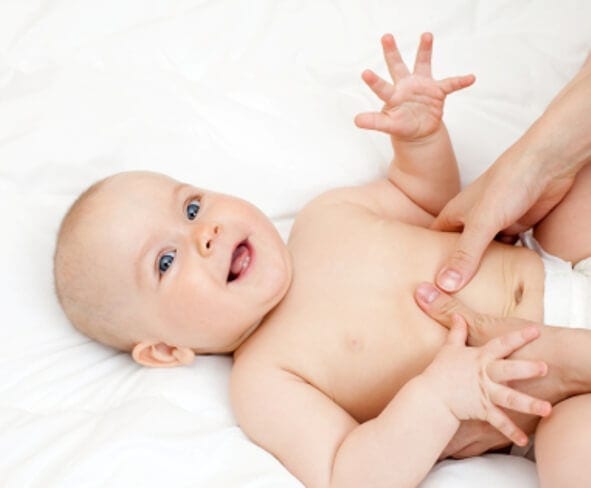For some, it appears constant crying is a normal occurrence in newborns. But is it? Colic is one of the most commonly reported ailments in infants aged 3 weeks to about 3 or 4 months. Extended periods of loud crying lasting longer than an hour are trademarks of the ailment, and are most frequent after being fed or late into the evenings.
Colic stems from problems with the infant’s immature digestive system. Trapped gas may cause the baby’s stomach to become distended, resulting in pain, bloating, the inability to pass gas, and frequent crying or screaming. Luckily, stimulation of the digestive process through careful massage may help ease the pain and urge relief from colic.
Research and Techniques in Massage for Colic Relief
A study printed in the Journal of Developmental and Behavioral Pediatrics supported the effects of massage on colicky infants. The researchers claim that massage therapy stimulated melatonin secretion and rest-activity rhythms in full-term infants. “Massage therapy by mothers in the perinatal period serves as a strong time cue, enhancing coordination of the developing circadian system with environmental cues.” In essence, massage helped relax infants and urge them to sleep, observing the natural circadian rhythms.
A Danish study further supports the claim that massage and reflexological treatments eased symptoms of colic in infants. The purpose of the study was to investigate and treat infants with colic by conventional medicine, followed by an investigation of the effect of reflexological treatment. “Infantile colic had a significant cure rate at pediatric consultation and the children who did not benefit from this intervention had a significantly better outcome after reflexological treatment than had the observation group.”
The addition of massage to treatments in the study proved more effective than traditional medicine alone.
Are you interested in becoming a certified massage therapist?
Visit the links below to explore our massage therapy programs at a campus near you:
Step-by-Step Guide to Massaging Colicky Infants
Massage for colicky infants is simple and stress-free. A few minutes of your time is enough to soothe the child, relieve symptoms of colic, and help create a tighter bond between parent and child.
The first step is called the paddlewheel. You may want to use a little massage oil or lotion on your hands before beginning. Place your palm under the infant’s chin, with fingers pointing towards the child’s shoulder. Draw your hand downward along the chest, towards their diaper. Repeat with slow, gentle motions.
In the second step, place your infant’s heel next to their bottom by bending the knee. With the leg still bent, move the thigh towards their stomach until it rests on their tummy. Move the other leg to this position as well. Slowly and carefully move the legs in a bicycle pattern. The infant may be confused at first, but they grow to love it.
Part three is also simple. Using as much of your palm and fingers as possible, circle the belly button in a clockwise motion. This motion will move the gas around, making it easier to pass for the infant.
For most parents, only five minutes per diaper change is enough to encourage a healthy digestive system, ease symptoms of colic, and promote a quiet and restful evening.
References
- Ferber, Sari Goldstein., et al. Massage therapy by mothers enhances the adjustment of circadian rhythms to the nocturnal period in full-term infants. Journal of Developmental & Behavioral Pediatrics. 2002 Dec: 23(6):410-415.
- Bennedbaeck, O., Viktor, J., Carlsen, KS., Roed, H., Vinding, H., Lundbye-Christensen, S. [Infants with colic: a heterogenous group possible to cure? Treatment by pediatric consultation followed by a study of the effect of zone therapy on incurable colic]. Ugeskr Laeger. 2001 Jul 2;163(27):373-8.
- Zeretske, Karen. Massage for Colic. New Beginnings. 1998 Jan: 15(1); 13.
Featured Posts:

